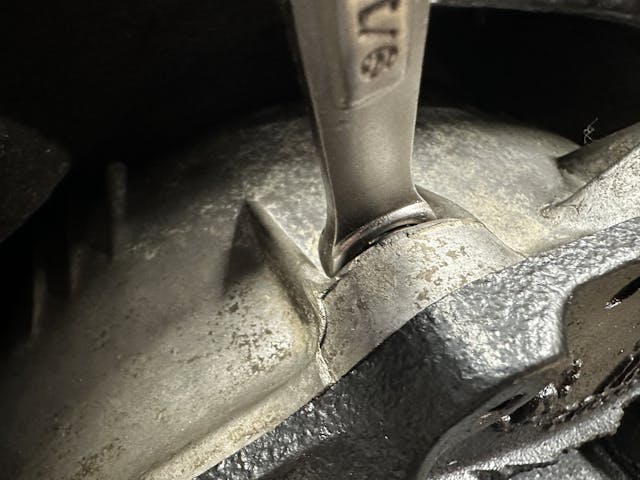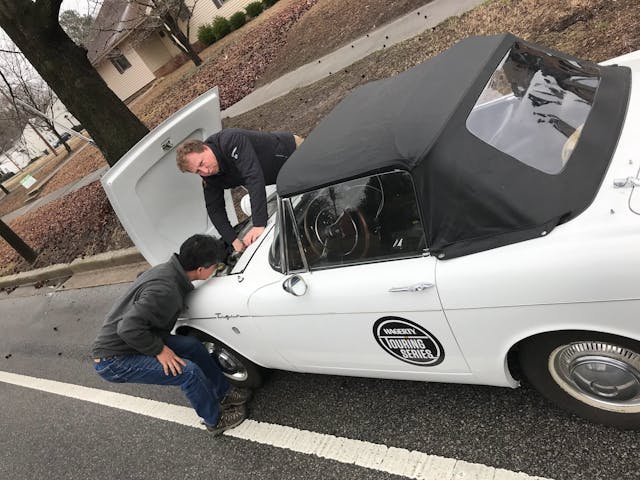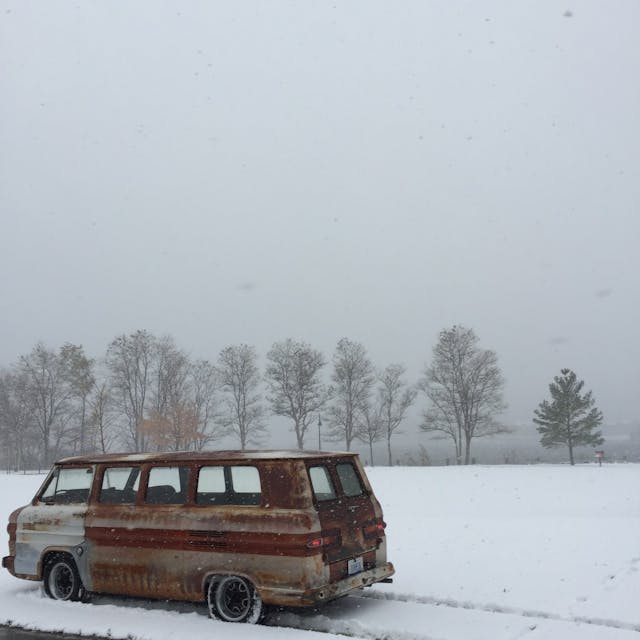Media | Articles
11 Rites of Passage for Every DIY Mechanic
Read all the books you want. Watch all the TV shows and YouTube mechanic videos that have ever been filmed. Sit and have a conversation with everyone who has turned a wrench. You still won’t be a mechanic, because practice and experience cannot be taught.
When younger enthusiasts recount certain adventures (or misadventures) to those with a few more years in the hobby, the seasoned folks will nod along. A mechanic’s rites of passage often need no explaining; by definition, these experiences have become universally accepted as ones that you must encounter and conquer to become proficient.
Which of these 11 rites of passage have you experienced, and which do you think changed you the most?
Rite of Passage #1: Roadside repair with makeshift parts
Whether on the road or in the shop, there comes a time when what you have is all you’ve got, and what you have just needs to work. Gaskets cut out of beer packaging, throttle cables made of shoestrings, or bailing wire on a part or piece that should be properly connected, but isn’t … If you understand a system well enough to engineer a functional fix on the fly, you truly understand how that system works.
Rite of Passage #2: Busted knuckles
You know the bolt is about to break free, so you give it a little extra oomph—and slam your hand into something. Usually, that something is heavy, rusty, or sharp … possibly, all three. Keep a record of your last tetanus shot handy, and know that we’ve all been there. Pulling towards yourself is often safer, except when it comes to cutting tools or other sharp implements.
Marketplace
Buy and sell classics with confidence
Rite of Passage #3: Trapped tools

The order of operations during disassembly and assembly is important—but you’ve got to pay attention to your tools, too. We’ve all been in situations when the excitement of a bolt coming loose makes us forget the limited space we’re working with, and suddenly our wrench is trapped between a bolt and a hard place.
Rite of Passage #4: Broken hardware

When a bolt chooses to Marie Antoinette itself, or threads stretch past the plasticity point and become unusable, progress can get tough. The fact of the matter is that rookies are more likely to break hardware, but there is a bit of a bell curve: As you tackle more and more projects, the quality of your work often rises; and then, as you gain confidence to handle the problems you now expect to encounter, the quality of your work tends to dip. Learning new methods for dealing with broken and stuck hardware is a never-ending quest for any wrench, green or seasoned.
Rite of Passage #5: Buying the shop manual
Just about everyone went through a phase when they felt as though they knew everything. Most advance out of such a state to understand that, even with everything they know, the shop manual knows more. Learning just how important and helpful a shop manual can be is often a freeing experience: Buying one is the first step to being self-sufficient because it allows you to solve problems without calling in experts or endlessly searching the web.
Rite of Passage #6: Disappearing parts
How else are you going to learn to organize your shop if you never experience the mildly panicked search for something you sat down right there? Everyone who ever gave you advice about doing DIY work probably told you to bag and tag parts and hardware, but most of us had to learn the benefits of organization the hard way to truly understand them.
Rite of Passage #7: Endless parts search

You saw that cool hunk of metal on the side of the road and just had to have it. Now you got it home and are excited to get to work and … Wait, there are no parts available for this? Sometimes the coolest models are the ones with the most problems and buying one that needs everything without realizing none of the parts exists is the gearhead’s version of falling in love with a crazy person: You often can’t give them what they need, and if you try, you’re going to be doing a lot of work (and probably spending a lot of money).
Rite of Passage #8: First rebuilt engine start-up
The thrum of a well-tuned engine is magnificent, but the stutter and cough of one chugging to life for the first time is even more enthralling. Was everything assembled correctly? Was anything forgotten? How is the combination of parts you chose going to work together? It all becomes clear with the first touch of the key. Weathering that storm of nerves is an experience unlike any other.
Rite of Passage #9: Ruined clothes
It was supposed to be a quick, clean job. Now that pair of jeans that used to be nice is stained with oil. (The situation is even worse if you’ve just ruined a pair of pants that your significant other specifically told you not to wear in the garage.) Typically when doing DIY work you dress to protect, not to impress. Hubris may protest, calling that an obvious truth, but the drawer of “work clothes” indicates we occasionally need a reminder.
Rite of Passage #10: Inclement weather moving in
Having a garage is a luxury that some of us take for granted. Most of us started by working on whatever we had wherever we could: Laying on our backs in gravel driveways, sitting cross-legged on the dirt of the back yard, or even leaning over core supports on the side of the street. If the sun was shining when you started work, your lack of protection from the elements becomes obvious as the clouds gather and the wind picks up. Being soaking wet, cold, and/or dirty while trying to assemble or diagnose your car is not fun, but we all must experience this misery to truly appreciate mild weather and good shelter.
Rite of Passage #11: Fixing what is not broken
The excitement to work on a project is sometimes so great that it must be satiated—even when there is work that needs to be done. I personally recall my father giving me the “if it ain’t broke, don’t fix it” speech while in my early teens; I had just made a mess of the garage floor taking apart something that had worked when I started and, more than likely, would never work correctly again. Poor thing.
Do you have to go through all of these to be a decent mechanic? Of course not, but many of us have experienced most, if not all, of these and more. Think we missed a rite of passage that changed you? Let us know about it in the comments below.
***
Check out the Hagerty Media homepage so you don’t miss a single story, or better yet, bookmark it. To get our best stories delivered right to your inbox, subscribe to our newsletters.














After working as an auto tech at one point in my career, I discovered that the most satisfying part of DIY was the luxury (if you’re able) of taking time to do things correctly, instead of slamming a job together. We’ve all had the experience when we hurry of finding that extra check ball from a carb we thought we’d rebuilt or in one case personally of accidentally dropping part of a carb linkage down an intake port & later finding it stuck between an intake valve & the valve seat (it was a Ford Flathead). Book learnin’ doesn’t tell you about this stuff.
You forgot driving any British Leyland vehicle round trip from Point A to Point B with the expectation that you will have to fix it somewhere along the way if you ever want to see home again.
Don’t forget the moisture displacement spray if there is any possibility of a water puddle along the way. I used to carry a can with me even though I never owned any Brit cars. Helped a few…
Kyle Smith – Yet another fantastic article! I love the comments as well! In the late 90’s, while stationed in Germany and returning from Grafenwöhr from a Field Training Exercise, I was a passenger in a HUMVEE for the return trip to Heidelberg. It was a long drive on a Sunday afternoon . There were few cars on the road and on Sunday’s, nothing in Germany is open for business. After about 30 minutes on the autobahn we got a flat. We had no tools, no spare parts and no service stations to assist. I had a Swiss Army Knife, my canteens with water and my foam ear plugs. We drove to the nearest little town and found they left the compressed air canister available. I used some of the air and water from my canteen to locate the leak and then crammed my earplug into the hole with the aid of my Swiss Army Knife’s Phillips screwdriver. We inflated the tire and caught up with our convoy we and they arrived at the Motor Pool. Otherwise, we would have waited for hours for the mechanics who left last in order to pickup, tow, or repair broken vehicles from behind! Great times, great memories and great lessons – thank you all, it sounds as if you’ve enjoyed this article as much as me!
In 1948, me 16 years old, no mechanical experience except bicycle repair, car 1934 Chev.
Car would crank but not start. Had to be spark or fuel problem. Removed the air cleaner,
punched a hole in a coffee can, set it on the carb, poured a little gas into the can,
got in the car, “cranked” the engine and and it started right up.
I would not recommend this, little did I know then, but it worked.
Dillinger
Great article with words of wisdom based on experience. The only items I would add are “Wear the safety gear” and “Keep the fire extinguisher handy.” Can’t count the number of times I burned my flesh from not wearing gloves or long sleeves. Nor, unfortunately, the times I got something in my eyes because I didn’t wear safety glasses. Luckily the disk part from the cutting wheel cut my cheek when the wheel broke, rather than flying into my eye. Again, I wasn’t wearing safety glasses. And I remember trying to put out the engine fire using dirt from the side of the road until a good Samaritan pulled up with his fire extinguisher. For this reason, every couple of years my Christmas gift to family members is a fire extinguisher for their vehicle.
The illusive 10mm socket. It’s the “Elf on the Shelf” of repair tools. One would swear that it’s actually sentient with a mind of it’s own. It seems to be the only tool that you can set down anywhere for less than a 5 seconds, turn back to retrieve it, and it’s gone never to be seen again.
In reply to all those who have ever lost a 10mm spanner of any kind: If you have to take your car into a workshop, remove your toolkit. Some thieving mechanic will lift all your 10s, 11s and 17s.
All of the above and some twice! I was a street mechanic at 15 years old and 1st time doing a tune up on an Olds Cutlass Convertible, for the Neiborhood biker guy. Cutting the ignition wires to length, 18436572, routing them out perfectly on the clips, new plugs, cap, rotor, condenser, turning the key and getting a clunk and then when the engine did spin it produced a backfire through the carb that sounded like someone shot off a howitzer. After wiping the singe off my right eyebrow, I began wondering if this is how my short life ends and complicating best escape routes all while trying to rethink everything I did over and over. Once the fight or flight adrenaline dissipated, which wasn’t long since I went right to flight anyway, I figured I would pull the #1 plug and tap it around to make sure the distributor was also at 1 when it blew off. With the cap off the distributor and my buddy tapping the key I noticed the distributor was !@#&#! turning counterclockwise! Who knew?
I tried to reroute the wires correctly, but they looked like a squirrel’s nest, so I happily went back to the parts store for another set of wires and used the first set on the next Chevy tune-up. Finished the rest of the tune up and it all worked out.
Some action items:
#1 Work hard to retain repeat customers. It is the best way of keeping all of your tools. You will find what you lost the last time they were in.
#2 Any electrical problems, ALWAYS check ground first, then go from there.
#3 If a Mopar doesn’t start when it is wet out, WD40 the distributor cap!
#4 If what you are doing is not working, take a break, walk away, most often when you come back to it you will have an a-ha moment.
Hearing a loud bang while driving then hearing nothing, followed by further investigation revealing large puddles on the ground and parts sticking through areas they shouldn’t be.
Locking yourself out of the house and having to find a piece of wire to hotwire the coil to jump the car. So, you can drive the car to get the extra keys.
Roll the car up on the curb so you can crawl under the car to get to the starter to smack it to get it cranking!
Parking on a hill so you can get it rolling fast enough so second gear on the automatic will kick in!
And all the other things we do as kids to keep going!!!
Here is a mechanic rite of passage that I experienced working on an airplane. I was assisting the local airframe & power plant mechanic perform an annual inspection on a Cessna 150. We had the engine cowling fully removed and started the engine to do a run up to check for any issues. What we missed was the 1/2” wrench sitting near the windshield. When the engine started it fell and lodged between the positive battery terminal and the firewall. Dramatic sparks and lots of yelling to shut down the engine ensued. I think we used a broom handle to pry it away from the firewall where it was now welded. It did take a small piece of the firewall with it!
I have done and seen some unbelievable roadside repairs. Three come to mind immediately.
#9–oil on clothes. But if you’re careful…I once visited a junkyard (not a nice clean “salvage yard,” a junkyard, mud, grease and all) on my lunch hour–in a coat and tie–to grab a window regulator for my BMW 2002–mine was broken, the window was stuck down and rain was predicted. Took the coat off, tucked the tie in my shirt and dismantled the parts car door to retrieve the regulator. Returning to the office, I spotted a three band Becker radio in a wrecked Mercedes, so grabbed that too. At the counter, the guys there couldn’t believe I had done it all without even getting my shoes muddy–just dirty hands. Washed my hands, put my treasures in the trunk, and back to work.
#10 Inclement weather. Moving from Austin TX to Denver Colorado. In November. In a Renault 4CV, followed by my wife in a VW Beetle. Climbed Trinidad pass on I 25. At the top, let off the gas. Still accelerating; the 6 foot long accelerator cable was frozen in its sheath. All the way down the mountain I could only slow down by switching off the engine and coasting–against 747 cc. Made it. Rapidly. Wife thought I was going so fast I’d kill us both–I had the maps so she had to follow closely. My repair? A hypodermic needle loaded with antifreeze injected into both ends of the cable. Never froze again.
My father told me the reason that my 1966 Beetle wasn’t running right was probably because the vacuum advance had gone bad. I didn’t believe him and changed points, plugs, wires, rebuilt the carb at least twice until I discovered that-surprise- the vacuum advance was bad. Got a new one, put it on the distributor and it ran great. That was about 1980. I figured that I should probably listen to him after that.
At 68, that mostly all reminds me of why I try hard to avoid working on things anymore.
If you are not learning, you are not living. I’m 62 and happy about it. I hate thinking about how ignorant I was years ago. Not stupid, ignorant. There is a difference. The biggest piece of advice I can give is talk to the old guys.